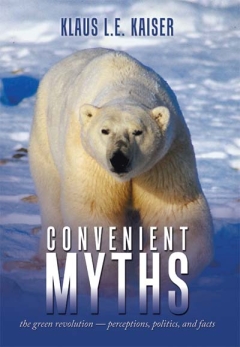|
|
CONVENIENT MYTHS
the
green revolution —
perceptions, politics, and
facts |
 |
by Klaus L.E. Kaiser, is the first clearly written, comprehensive
book looking at the green desires and expectations and juxtaposing
these with the physical and chemical facts and realities.
CONVENIENT MYTHS explains in common terms why many of these
green ideas will remain myths and dreams. The laws of nature cannot
be broken. No matter how much we may desire the opposite.
Keywords / Chapters:
|
Climate change, global warming, IPCC, government, media, propaganda, deficit, inflation, earthquakes, volcanos,
pollution, ice ages, greenhouse gases, carbon dioxide, methane, water vapor, sea ice, Arctic, polar bears, seals, whales,
energy, temperature, cod, salmon, El Nino, hurricanes, typhoons, earth, freshwater, deforestation, physics, chemistry, biology,
freshwater, aquifers, desalination, disinfection, fluoridation, air, ozone, smog, acid rain, crude oil, coal, natural gas, electric power,
electric cars, fossil fuels, natural gas, nuclear, geothermal, heat pump, wave power, osmosis, wind, solar energy, biofuels, ethanol, engine,
hybrid, hydrogen, light, food, organic, genetically modified, fish, contaminants, sun, radiation, light, X-rays,
weather, droughts, floods, diseases, longevity, cancer, Alzheimer's, malaria, progress |
|
Book Excerpts
The Oceans
Liquid, or sometimes solid water (ice) covers much of the earth's surface, approximately 7/10th of it. Anyone flying across an ocean must have thought about the
vast stretch of open water, most of it miles deep below its surface.
The Vikings and the ancient mariners plying the Indian Ocean in small vessels, Columbus and all the other explorers, adventurers, and countless fishermen surely were
braving unfavorable odds. From J. Verne's "20,000 Leagues under the Sea" to T. Heyerdahl's "Kon-Tiki," or S. Sontag's and C. Drew's "Blind Man's Bluff," fictitious
and real stories about man's adventurers on the high seas abound.
Even in the 21st century, mysteries abound about monster sea creatures, which fascinate the mind. And the lore about smaller "oceans" is no less abundant and exciting.
Slowly but surely, the ocean's resources are being exploited by man, often without understanding or interest in long-term consequences. From the whaling activities
in the 19th century, to modern 50 km long free-floating drift-nets on the open ocean, and "catch-all" bottom-trawling rigs scraping along the continental shelves,
and their ocean-plying fish-processing plants, man is harvesting nearly everything the oceans can deliver.
Figure 32 shows a schematic drawing of a bottom trawl as they are deployed in many commercial fishing operations. While banned from the North American west
coast for several years now, the highly destructive bottom trawls, some of them termed "Canyonbusters" because of their size and ability to overcome the "obstacles"
of coral reefs, continue to operate in many parts of the world's oceans.
In shallower nearshore waters, such as in the Gulf of Mexico, numerous crude oil and natural gas wells and production platforms dot the seascape. More recently,
deep-sea drilling platforms, able to explore for and produce hydrocarbons from the layers up to ten km below the sea's surface are being deployed.
In the Baltic, offshore wind turbines surround the coast of Denmark in its nearshore waters.
The waters and sediments of the Arctic Ocean, even where covered with thick sea ice are becoming increasingly studied for their resource potential.
From a biological perspective, the oceans are home to the largest mammals on earth, the blue whale, and to the largest single-species biomass, krill (Euphausia superba),
a small, 2 to 5 cm long kind of shrimp, in the Antarctic Ocean. [Source: Wikipedia].
Along the mid-oceanic ridges (where tectonic plates part) sea vents at depths of thousands of meters are teaming with life in complete darkness. The organisms
there have evolved to use the energy of emitted sulfur compounds to sustain their life cycle....
Back to excerpts
|
|
| Copyright © 2010-2023, Klaus L.E. Kaiser. All Rights Reserved. |
|



